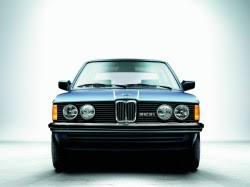BMW 3 Series E21
BMW E21 is the body designation for the first BMW 3 Series compact executive car, produced by the German automaker BMW from 1975 to 1983. This series was the immediate successor to the BMW 2002 and was superseded by the BMW E30 platform.
In July 1975, BMW’s Board of Management first presented this new model series in the Munich Olympic Stadium for public appraisal. The frontal view of the new car was dominated by the BMW trademark kidney grille standing out clearly from the radiator cover. The styling of the new car bore a resemblance to the BMW E12 5 Series.
The wedge shape of the two-door model was distinctive, extending all the way to the unusually high rear end. In response to criticism of the tail design, a black plastic trim panel between the tail lights was added. The car's styling was otherwise well received.
Measuring 4355 millimeters (171.5 inches) in length, 1610 millimeters (63.4 inches) in width, and 1380 millimeters (54.3 inches) in height, the E21 Series continued the tradition of the New Class. With the wheelbase measuring 2563 millimeters (100.9 in), there was little body overhang in the rear wheel drive design. The track measured 1364 millimeters (53.7 in) at the front, and 1377 millimeters (54.2 in) at the rear.
The suspension incorporated rack and pinion steering and McPherson strut suspension at the front, and semi-trailing arm type independent suspension at the rear. The power assisted brakes were discs on the front wheels, while the rear wheels had drum brakes.
Initially, a Getrag four-speed manual was the standard transmission fitment. Five-speed Getrag gearboxes were fitted as standard in the 323i and others in later years, but were available at the car's release as an option, with gear ratio sets favoring either performance or economy. Alternatively, purchasers could opt for the ZF 3 HP-22 three-speed automatic transmission.
The cockpit design of the E21 marked the introduction of a new design concept, with the center console angled towards the driver. This feature has become part of BMW’s interior design philosophy for many years. As a sign of passive safety, all edges and control elements within the interior were rounded off and padded.
At the E21's release, three models were available: with 316 (1.6 litre), 318 (1.8 litre) and 320 (2.0 litre) versions of the BMW M10 four cylinder engine. To draw clear visual distinction within the new model series, the 320 models came with dual headlights, while the 316 and 318 had single round headlights.
At the end of 1975, the 320i was introduced; the engine was fitted with Bosch K Jetronic fuel injection, delivering 125 bhp (93 kW) on premium grade gasoline.
At introduction in the German market, the entry-level 316 retailed at DM 13 600, the 318 sold for DM 14 420, and the two 2.0 L models went for DM 15 330 and DM 17 400 respectively.
DM-Germans marks
BMW 320i witj K Jetronic fuel injection |
In the mid 1970s, BMW had invested DM 110 million in a new engine series, designated as the M60, but later renamed as M20 upon the introduction of the E30 in late 1982.
At the 1977 International Auto Show in Frankfurt, BMW unveiled its new variants of the E21, featuring the new six-cylinder M20 engines. The four cylinder 320 model was replaced with the 320/6, featuring a two litre version of the M20 engine. The 323i model was introduced, featuring 2.3 litres and 143 bhp (107 kW; 145 PS) , empowering this car with a top speed of approximately 190 km/h (118 mph). The braking system was also upgraded, with the 323i featuring disc brakes on all wheels.
In the meantime however, a performance gap had developed between the 98 bhp (73 kW; 99 PS) 318 and the new 320/6 delivering 122 bhp (91 kW; 124 PS). For the 1979/80 model year, the four-cylinder models were upgraded: the 1.8 litre power unit was revised and entered the market as a 90 bhp (67 kW; 91 PS) carburetor engine in the 316, while addition of Bosch K Jetronic fuel injection to the 1.8 litre engine raised the 318i to 105 bhp (78 kW; 106 PS) .
Since there was now also room for a new entry-level model, the 315 powered by a 75 bhp (56 kW; 76 PS) 1.6 litre M10 engine made its appearance in 1981.


